Don't you sometimes yearn for the simple life? A time when firmware upgrades weren’t a daily chore, when internet-based VOD was just a theory, and when a TV could be operated by those over forty?
Our quick take
The TX-L32E3B tries the ‘less is more’ approach, but fails. Not because it misses off flashy features, but primarily because it misses off access to BBC iPlayer, which we now consider that a living room staple.
Kudos to Panasonic for packing a Freeview HD tuner is this well built yet remarkably slim budget offering, but some picture foibles and odd omissions make this Edge LED set feel like a lost opportunity. There are better value options available for most of us, though the tech-afraid will love the TX-L32E3B.

Panasonic TX-L32E3B - 3.0 / 5
| FOR | AGAINST |
|---|---|
|
|
Panasonic has taken the ‘less is more’ approach to its latest entry-level TV, no bad thing in theory, but perhaps even stretch it a little too far. 3D? You’ll not find that here. But surely some home networking or online video? Nope. What about a couple of lovely USB slots? Nada!
Picture quality
What this 32-incher does have, however, are a couple of upgrades you wouldn't have found on a similar TV a few years ago; edge LED backlighting and a Freeview HD tuner. The latter has an Ethernet LAN port in tow - part of the Freeview HD spec, but it doesn't do anything exciting.
The edge LED panel used by the TX-L32E3B is of the IPS Alpha variety, which should give us some decent contrast and a smooth picture. Except it doesn’t; switch the TX-L32E3B on and the picture appears to suffer not only from relatively poor contrast - we’re talking a sheen of blue-ish, gray-ish tones where there should be jet black - that’s not nearly as dynamic as we’d hoped for, but also some motion blur.

That’s a shame, since the rest of the picture - is this case, Frozen Planet on Freeview HD - seems incredibly natural in terms of colour, something that’s helped by a lot of detail. When those polar bears get going, however, the camera movements bring a sheen of blur across the arctic that renders a good portion of that Full HD detail pointless. Switch to Blu-ray and it’s a similar story.
To be fair to the TX-L32E3B, its picture is always watchable, something that’s largely due to a virtual lack of processing circuitry. There is CATS (contrast automatic tracking system) to ignore, as it tends to make panel brightness rather twitchy. And a resolution enhancer - almost alone in the ‘Advanced Settings’ picture menu - to twiddle with for DVDs. However, the TX-L32E3B is probably best left on one of its preset picture modes, with cinema or true cinema - the latter a touch brighter - the main candidates.
Poor audio and Viera Tools
There are some strange decisions elsewhere. Probably the most annoying is the poor audio, which stem from what is probably one of the TX-L32E3B’s biggest surprises considering its budget status - its 41mm depth. Trouble is, the 10W stereo speakers strapped to its undercarriage don't have nearly enough room to create much in the way of audio, with a treble-heavy, thin soundstage emanating from them.

Viera Tools, a shortcut on the excellent remote control that normally leads to a Panasonic TV’s central functions, here merely points you in the direction of music, video and photo files stored on a SD Card. That’s right, folks - there’s a SD Card slot instead of USB gadgetry. Clearly aimed at those with a digital camera, though not necessarily a computer, the TX-L32E3B was able to play JPEG photos, MP3 music and both MP4 and MPEG files in our test There was no AVI or MKV support.
Elsewhere in the E3 Series are 37-inch and 42-inch models, though we'd seriously consider upgrading to Panasonic’s E30 Series, an only slightly dearer range that benefits from Viera Connect online platform that includes access to BBC iPlayer – something that’s sorely missed on this otherwise living room-friendly option.
To recap
A basic TV that's let down by the lack of integrated iPlayer and some aspects of the panel itself
